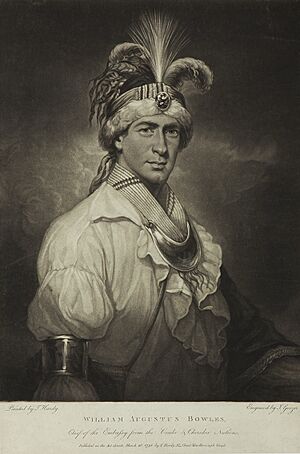State of Muskogee facts for kids
Quick facts for kids
State of Muskogee
|
|||||||||||
|---|---|---|---|---|---|---|---|---|---|---|---|
| 1799–1803 | |||||||||||
|
Flag of the State of Muskogee
|
|||||||||||
|
Motto: Liberty or Death
|
|||||||||||
| Status | Republic | ||||||||||
| Capital | Mikasuke (near Tallahassee) | ||||||||||
| Largest city | N/A | ||||||||||
| Common languages | English, Muskogean languages | ||||||||||
| Religion | Roman Catholic | ||||||||||
| Government | Free State | ||||||||||
| Director General | |||||||||||
|
• 1799–1803
|
William Augustus Bowles | ||||||||||
| Legislature | Chamber of Deputies | ||||||||||
| History | |||||||||||
|
• Independence declared
|
1799 | ||||||||||
|
• Capture of William Bowles
|
May 24 1803 | ||||||||||
| Population | |||||||||||
|
• 1799
|
50,000-60,000 | ||||||||||
| Currency | USD | ||||||||||
|
|||||||||||
The State of Muskogee was a country that existed for a short time in Florida. It was founded in 1799 by William Augustus Bowles. He was a Loyalist who fought in the American Revolutionary War. Bowles lived among the Muscogee people and dreamed of uniting Native American tribes in the Southeast. He wanted to create a strong nation that could stand against the growing United States.
Bowles had the support of the Miccosukee (Seminole) and several groups of Muscogee people. He hoped his state would eventually include the Cherokee, Choctaw, and Chickasaw tribes. These tribes lived in parts of what are now Georgia and Alabama.
Contents
The Story of Muskogee
William Bowles' Early Life
William Bowles was born into a family that supported the British during the American Revolution. When he was just 14, he joined the British army. He was sent to Pensacola, Florida, but he lost his rank because he didn't follow orders.
After this, Bowles went to live with the Muscogee people near the Tallapoosa River and Apalachicola River. He quickly learned their language and married women from the Cherokee and Muscogee tribes. He became an important leader among the Muscogee.
Fighting and New Ideas
Bowles led Muscogee warriors in battles during the American Revolution. After the war, he moved to the Bahamas. There, a British governor encouraged him to return to the Muscogee. The governor wanted Bowles to help break a trade company's control over the fur trade with Native Americans. During this time, Bowles developed his idea for an independent Native American state.
He tried to take over a trading post but failed. Spanish authorities then saw him as a criminal. For several years, Bowles traveled between Nova Scotia, the Bahamas, England, and Native American villages. He gained support for his idea of a free State of Muskogee. He promised the Lower Creeks and Seminoles that the British would support them.
Creating the State of Muskogee
In 1792, Bowles led a group of Muscogee warriors who captured a Spanish trading post. He tried to talk with the Spanish about creating a Muskogee state. Instead, the Spanish captured him. They imprisoned him far away in Cuba, Madrid, and even Manila.
But Bowles was determined. While being moved back to Spain, he escaped and took control of a ship. He eventually made his way back to Florida in 1799.
Once in Florida, Bowles declared himself "Director General and Commander-In-Chief of the Muskogee Nation." On October 31, 1799, he announced that a treaty between Spain and the United States was invalid. He said it ignored the Native Americans' right to their land in Florida. He also threatened war against the U.S. if they didn't return lands he claimed they took unfairly.
Bowles welcomed runaway slaves, and many Black Seminoles supported him. He also had the support of the Seminoles and other Creek groups. This was because he provided them with gunpowder and promised more if he captured the Spanish trading post at San Marcos.
Challenges and the End of Muskogee
Spanish attacks forced Bowles to move his capital to the town of Miccosukee (or Mikasuki). This town was near present-day Tallahassee. It was ruled by Mico Kinache, Bowles's father-in-law and a strong ally. Some English adventurers from the Bahamas helped Bowles run the government.
Bowles even built a small navy of three ships and attacked Spanish ships. In 1800, a Spanish army tried to destroy Miccosukee but got lost in the swamps. In 1802, Bowles led a large force of Seminoles, Black Seminoles, runaway slaves, and others to attack San Marcos. However, he had to retreat when Spanish ships arrived.
A peace treaty signed in Europe in March 1802 briefly ended fighting between Britain, France, and Spain. This news weakened Bowles's position. The Seminoles, including Kinache, then signed a treaty with Spain in August.
By 1803, the United States and Spain were working together against Bowles. He no longer had British support. He was tricked into attending a tribal meeting where he was captured. He was then handed over to the Spanish governor in Pensacola. Bowles was imprisoned in Havana, Cuba, where he died in 1805.
The short-lived State of Muskogee showed that Spain struggled to control the interior of Florida. Years later, in 1818, the town of Miccosukee was destroyed by General Andrew Jackson's army during the First Seminole War.



